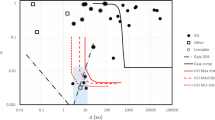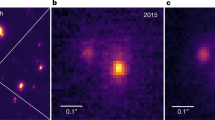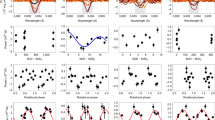Abstract
Hot Jupiters are giant Jupiter-like exoplanets that orbit their host stars 100 times more closely than Jupiter orbits the Sun. These planets presumably form in the outer part of the primordial disk from which both the central star and surrounding planets are born, then migrate inwards and yet avoid falling into their host star1. It is, however, unclear whether this occurs early in the lives of hot Jupiters, when they are still embedded within protoplanetary disks2, or later, once multiple planets are formed and interact3. Although numerous hot Jupiters have been detected around mature Sun-like stars, their existence has not yet been firmly demonstrated for young stars4,5,6, whose magnetic activity is so intense that it overshadows the radial velocity signal that close-in giant planets can induce. Here we report that the radial velocities of the young star V830 Tau exhibit a sine wave of period 4.93 days and semi-amplitude 75 metres per second, detected with a false-alarm probability of less than 0.03 per cent, after filtering out the magnetic activity plaguing the spectra. We find that this signal is unrelated to the 2.741-day rotation period of V830 Tau and we attribute it to the presence of a planet of mass 0.77 times that of Jupiter, orbiting at a distance of 0.057 astronomical units from the host star. Our result demonstrates that hot Jupiters can migrate inwards in less than two million years, probably as a result of planet–disk interactions2.
This is a preview of subscription content, access via your institution
Access options
Subscribe to this journal
Receive 51 print issues and online access
$199.00 per year
only $3.90 per issue
Buy this article
- Purchase on Springer Link
- Instant access to full article PDF
Prices may be subject to local taxes which are calculated during checkout




Similar content being viewed by others
References
Lin, D. N. C., Bodenheimer, P. & Richardson, D. C. Orbital migration of the planetary companion of 51 Pegasi to its present location. Nature 380, 606–607 (1996)
Baruteau, C. et al. inProtostars and Planets VI (eds Beuther, H., Klessen, R., Dullemond, C. & Henning, T. ) Vol. 914, 667–689 (Univ. Arizona Press, 2014)
Chatterjee, S., Ford, E. B., Matsumura, S. & Rasio, F. A. Dynamical outcomes of planet-planet scattering. Astrophys. J. 686, 580–602 (2008)
Setiawan, J. et al. A young massive planet in a star–disk system. Nature 451, 38–41 (2008)
Huélamo, N. et al. TW Hydrae: evidence of stellar spots instead of a hot Jupiter. Astron. Astrophys. 489, L9–L13 (2008)
van Eyken, J. C. et al. The PTF Orion project: a possible planet transiting a T-Tauri star. Astrophys. J. 755, 42–55 (2012)
Kraus, A. L. & Ireland, M. J. LkCa 15: a young exoplanet caught at formation? Astrophys. J. 745, 5–16 (2012)
Sallum, S. et al. Accreting protoplanets in the LkCa 15 transition disk. Nature 527, 342–344 (2015)
Donati, J.-F. et al. The large-scale magnetic field and poleward mass accretion of the classical T Tauri star TW Hya. Mon. Not. R. Astron. Soc. 417, 472–487 (2011)
Mahmud, N. I. et al. Starspot-induced optical and infrared radial velocity variability in T Tauri star Hubble I 4. Astrophys. J. 736, 123–131 (2011)
Donati, J.-F. et al. Modeling the magnetic activity and filtering radial velocity curves of young Suns: the weak-line T Tauri star LkCa 4. Mon. Not. R. Astron. Soc. 444, 3220–3229 (2014)
Donati, J.-F. et al. Magnetic activity and hot Jupiters of young Suns: the weak-line T Tauri stars V819 Tau and V830 Tau. Mon. Not. R. Astron. Soc. 453, 3707–3720 (2015)
Grankin, K. N., Bouvier, J., Herbst, W. & Melnikov, S. Y. Results of the ROTOR-program. II. The long-term photometric variability of weak-line T Tauri stars. Astron. Astrophys. 479, 827–843 (2008)
Siess, L., Dufour, E. & Forestini, M. An internet server for pre-main sequence tracks of low- and intermediate-mass stars. Astron. Astrophys. 358, 593–599 (2000)
Kraus, A. L., Ireland, M. J., Hillenbrand, L. A. & Martinache, F. The role of multiplicity in disk evolution and planet formation. Astrophys. J. 745, 19–29 (2012)
Donati, J.-F., Semel, M., Carter, B. D., Rees, D. E. & Collier Cameron, A. Spectropolarimetric observations of active stars. Mon. Not. R. Astron. Soc. 291, 658–682 (1997)
Vogt, S. S., Penrod, G. D. & Hatzes, A. P. Doppler images of rotating stars using maximum entropy image reconstruction. Astrophys. J. 321, 496–515 (1987)
Donati, J.-F. & Collier Cameron, A. Differential rotation and magnetic polarity patterns on AB Doradus. Mon. Not. R. Astron. Soc. 291, 1–19 (1997)
Donati, J.-F., Collier Cameron, A. & Petit, P. Temporal fluctuations in the differential rotation of cool active stars. Mon. Not. R. Astron. Soc. 345, 1187–1199 (2003)
Morin, J. et al. The stable magnetic field of the fully convective star V374 Peg. Mon. Not. R. Astron. Soc. 384, 77–86 (2008)
Mortier, A., Faria, J. P., Correia, C. M., Santerne, A. & Santos, N. C. BGLS: A Bayesian formalism for the generalised Lomb-Scargle periodogram. Astron. Astrophys. 573, 101–106 (2015)
Haywood, R. D. et al. The Sun as a planet-host star: proxies from SDO images for HARPS radial-velocity variations. Mon. Not. R. Astron. Soc. 457, 3637–3651 (2016)
Lucy, L. B. & Sweeney, M. A. Spectroscopic binaries with circular orbits. Astron. J. 76, 544–556 (1971)
Petit, P. et al. A maximum entropy approach to detect close-in giant planets around active stars. Astron. Astrophys. 584, 84–91 (2015)
Mayor, M. et al. The HARPS search for southern extra-solar planets. Occurrence, mass distribution and orbital properties of super-Earths and Neptune-mass planets. Preprint at http://arxiv.org/abs/1109.2497 (2011)
Wright, J. T. et al. The frequency of hot Jupiters orbiting nearby solar-type stars. Astrophys. J. 753, 160–164 (2012)
Winn, J. N. & Fabrycky, D. C. The occurrence and architecture of exoplanetary systems. Annu. Rev. Astron. Astrophys. 53, 409–447 (2015)
Ogilvie, G. I. Tidal dissipation in stars and giant planets. Annu. Rev. Astron. Astrophys. 52, 171–210 (2014)
Goldreich, P. & Soter, S. Q in the Solar System. Icarus 5, 375–389 (1966)
Donati, J.-F. et al. Magnetometry of the cTTS GQ Lup: non-stationary dynamos and spin evolution of young Suns. Mon. Not. R. Astron. Soc. 425, 2948–2963 (2012)
Donati, J.-F. ESPaDOnS: An Echelle SpectroPolarimetric Device for the Observation of Stars at CFHT. ASP Conf. Proc. 307, 41–50 (2003)
Chené, A. N. et al. GRACES: Gemini remote access to CFHT ESPaDOnS spectrograph through the longest astronomical fiber ever made: experimental phase completed. Proc. SPIE 9151, 47–62 (2014)
Moutou, C. et al. Spectropolarimetric observations of the transiting planetary system of the K dwarf HD 189733. Astron. Astrophys. 473, 651–660 (2007)
Kurucz, R. ATLAS9 atmospheric models, ATLAS9 and SYNTHE routines, spectral line database. CDROM 13 and 18, http://kurucz.harvard.edu/cdroms.html (1993)
Collier Cameron, A. Spot mapping in cool stars. Lecture Notes Phys. 573, 183–206 (2001)
Morin, J. Magnetic fields from low-mass stars to brown dwarfs. EAS Publ. Ser. 57, 165–191 (2012)
Acknowledgements
This paper is based on observations obtained at the CFHT Corporation (operated by the National Research Council of Canada, the Institut National des Sciences de l’Univers of the Centre National de la Recherche Scientifique (INSU/CNRS) of France and the University of Hawaii), at the Télescope Bernard Lyot (TBL) (operated by the Observatoire Midi-Pyrénées and by INSU/CNRS), and at the Gemini Observatory (operated by the Association of Universities for Research in Astronomy under a cooperative agreement with the National Science Foundation (NSF) on behalf of the Gemini partnership: the NSF of the United States, the National Research Council of Canada, CONICyT of Chile, the Ministerio de Ciencia, Tecnología e Innovación Productiva of Argentina, and the Ministério da Ciência, Tecnologia e Inovação of Brazil). We thank the Queue Service Observing teams of CFHT, TBL and the Gemini Observatory, without whom this study would not have been possible. We also thank the IDEX initiative of Université Fédérale Toulouse Midi-Pyrénées for awarding a ‘Chaire d’Attractivité’ to G.H., in the framework of which this work was done. S.A. acknowledges financial support from Conselho Nacional de Desenvolvimento Científico e Tecnológico (CNPq), Coordenação de Aperfeiçoamento de Pessoal de Nível Superior (CAPES) and Fundação de Amparo a Pesquisa do Estado de Minas Gerais (Fapemig).
Author information
Authors and Affiliations
Contributions
This work merged data collected with two different instruments and three different telescopes. J.F.D. led the data processing, analysis and manuscript preparation. C.M., L.M., L.Y. and E.H. participated in the data collection and data analysis. C.B. contributed to the theoretical implications of the results. All authors, including G.H., S.A., M.T., F.M., J.B., P.P., R.D. and A.C.C., were involved in elaborating the observing proposals, in discussing the results at various stages of the analysis, and in providing contributions to older versions of the manuscript.
Corresponding author
Ethics declarations
Competing interests
The authors declare no competing financial interests.
Extended data figures and tables
Extended Data Figure 1 Estimating the surface differential rotation parameter.
Variations of the reduced χ2 as a function of the surface differential rotation parameters Ωeq and dΩ, denoting respectively the rotation rate at the equator and the difference in rotation rate between the equator and the pole (and assuming a solar-like sine-square differential rotation law). The location of the minimum and the local paraboloid curvature yield the optimal parameters and their respective 1σ error bars19, equal to 2.29525 ± 0.00020 and 0.0172 ± 0.0014 radians per day. The outer colour contour traces the 99.99% confidence interval (corresponding to a χ2 increase of 18.4 for a two-parameter optimization problem).
Extended Data Figure 2 Complementary periodograms.
a, Same as Fig. 3a (middle plot) using the BGLS approach21, showing that the 4.93-day peak we detect is at least 105 times more likely than any other features. b, Same as Fig. 3b for Hα emission, another activity proxy, featuring a clear peak at the stellar rotation period but no power at the planet orbital period. c, Same as Fig. 3a (middle plot) for our new data combined with the 2015 January subsample of our original data12. The planet is now detected with a higher confidence level (FAP < 10−5) but the accuracy of the orbital period is not much improved (with multiple nearby peaks of similar strength). The red and green dashed lines are for the original and new data respectively. d, Same as c, zooming on the orbital frequency. The orbital period corresponding to the strongest peak is equal to 4.924 ± 0.004 days (1σ error bar).
Extended Data Figure 3 Periodograms of simulated data.
a, Same as Fig. 3, for simulated data computed using the brightness map, differential rotation and planet parameters inferred from the real data, and assuming the same coverage and similar S/N (equal for all LSD profiles). As for our observations, the planet signal is detected at a confidence level >99.9% in the filtered radial velocities despite being invisible in the raw radial velocities, and the planet parameters are well recovered. The periodogram of the raw radial velocities is very similar to that of Fig. 3, featuring the main peaks (at Prot and Prot/2) and their aliases; residual radial velocities mostly reflect the noise in the data. b, Same as the upper two panels of a but with no planet included in the simulation. No signal with a confidence level >90% is recovered in the filtered radial velocities, demonstrating that the filtering process is not generating spurious radial velocity signals, in particular at a period of 4.93 days.
Extended Data Figure 4 Radial velocity curves of simulated data.
a, Same as Fig. 2a for the simulated data described in Extended Data Fig. 3a (using the same brightness map, differential rotation and planet parameters as those of V830 Tau b). The simulated radial velocities (periodograms shown in Extended Data Fig. 3a) share obvious similarities with the observed ones, and the planet signal is safely recovered (root-mean-square dispersion of residual radial velocities equal to 45 m s−1). b, Same as the middle panel of a but with no planet included. As for the periodogram (see Extended Data Fig. 3b, bottom panel), no signal is detected, further illustrating that activity induces no spurious planet signature. As for Fig. 2, simulated radial velocity measurements are depicted in all panels with their 1σ error bars.
Rights and permissions
About this article
Cite this article
Donati, J., Moutou, C., Malo, L. et al. A hot Jupiter orbiting a 2-million-year-old solar-mass T Tauri star. Nature 534, 662–666 (2016). https://doi.org/10.1038/nature18305
Received:
Accepted:
Published:
Issue Date:
DOI: https://doi.org/10.1038/nature18305
This article is cited by
-
The CUBES science case
Experimental Astronomy (2023)
-
Rapid contraction of giant planets orbiting the 20-million-year-old star V1298 Tau
Nature Astronomy (2021)
-
A planet within the debris disk around the pre-main-sequence star AU Microscopii
Nature (2020)
Comments
By submitting a comment you agree to abide by our Terms and Community Guidelines. If you find something abusive or that does not comply with our terms or guidelines please flag it as inappropriate.



